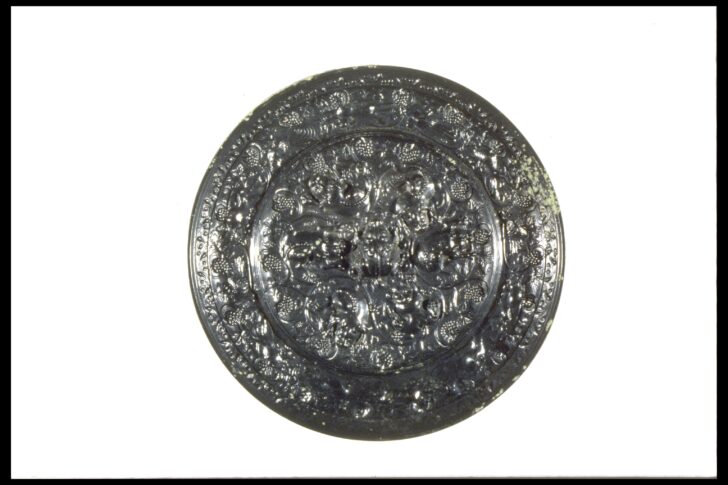Mirror, Lion-and-Grape type
Chinese

Description
Luxury Chinese Mirrors
China has had mirrors since the late second millennium BCE. Traditional Chinese mirrors took the form of bronze disks with a polished reflecting surface and relief decorations cast on the back, as seen in these four examples from a wide range of dynastic periods. A braided silk cord was passed through the knob at the center of the back that was used as a handle for the mirror. Variations in the surface color or the patina of these mirrors—from silvery to green to black—result from different ratios of copper and tin (the components of bronze) and burial conditions, as mirrors were personal accessories that customarily accompanied the deceased to the afterlife.
5. Mirror with hook-and-volute
dragon design
China, Warring States period,
Eastern Zhou dynasty (771-256 BCE)
3rd century BCE
Cast bronze with silver and malachite patina
Museum purchase, 1958/2.76
Decoration on the backs of bronze mirrors
usually follows the styles current in metalwork
of the period. The delicate design on this
Warring States-period mirror is a beautiful
curvilinear pattern known as hook-and-volute–
a highly abstracted form of a dragon. It is found
on bronze vessels as well as textile decoration
from the period.
6. Animal cycle type mirror
China, Sui (581-618) or Tang dynasty (618-907)
7th century
Cast bronze with malachite and azurite patina
The Oliver J. Todd Memorial Collection,
1974/1.180
Ideas or motifs from Daoism and its practical
offshoot, fengsui philosophy, sometimes appear
on mirror backs as embellishments. The inner
decorative field of this seventh-century mirror
is decorated with the Four Spirits, animals that
represent the four points of the compass: the
blue dragon represents the east, the red bird
the south, the white tiger the west, and a snake
or tortoise, known as the “dark warrior,” the
north. On the outer field are the twelve familiar
animals of the Chinese zodiac.
7. Mirror with tiger design and eight-
character inscription
China, Eastern Han dynasty (25-220 CE)
Cast bronze with malachite and silver patina
The Oliver J. Todd Memorial Collection,
1974/1.168
From Han times short inscriptions of a
symbolic or auspicious nature also began to
appear as decoration on the backs of bronze
mirrors. Surrounding the large central knob
of this mirror are stylized crouching tigers.
Between them is an eight-character inscription
that perfectly captures the aspirations of the
scholarly class in Han-dynasty China: zhangyi
zisun, junyi gaoguan, or “across many generations
of sons and grandsons, may [your descendants]
always attain high official positions.”
8. Lion-and-grape mirror
China, Tang dynasty (618-907)
Cast bronze with black patina
Museum purchase, 1958/2.74
In the Tang dynasty, it was the lion and the
grape motif that appealed most to wealthy
members of society for the decoration of
mirrors. Grapes had been introduced through
trade with west Asia during the Han dynasty
(206 BCE– 220 CE) and clusters of grapes came
to be associated in China with prosperity and
large numbers of offspring. Lions had been
symbols of royal authority in ancient Persia and
India and entered China as exotic tributes from
Central Asia. They became a popular motif on
Pan-Asian metalwork and textiles of the period.
The best of the lion-and-grape mirrors, with
their vigorous designs cast in sharp, high relief,
as seen in this example, rank among the finest
metalwork produced in Chinese history.
Fall 2022 Gallery Rotation
__________
March 28, 2009
In the Tang dynasty, it was the lion and grape motif that appealed most to wealthy members of society for the decoration of mirrors. Grapes had been introduced through trade with west Asia during the Han dynasty (206 BCE–220 CE) and clusters of grapes came to be associated in China with prosperity and large numbers of offspring. Lions had been symbols of royal authority in ancient Persia and India and entered China as exotic tributes from Central Asia. They became a popular motif on Pan-Asian metalwork and textiles of the period. The best of the lion-and-grape mirrors, with their vigorous designs cast in sharp, high relief, as seen in this example, rank among the finest metalwork produced in Chinese history.
Subject Matter:
Bronze mirror of the Tang Empire in Middle Period China, decorated with Persian inspired design of lions (also known as sea beast) and grapes
Physical Description:
bronze mirror with highly polished surface, back side deocrated with lions and grape motif and an animal shaped knob in the center.
Usage Rights:
If you are interested in using an image for a publication, please visit https://umma.umich.edu/request-image/ for more information and to fill out the online Image Rights and Reproductions Request Form.